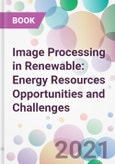The topics covered include uncertainty analysis methods, computing technologies, automated control systems, performance analysis, riverfront analysis through image processing and solar power estimation methods, to name a few. The information is also complemented with a review of problems in the electric power sector in India.
This book is beneficial for professionals and researchers who work on hybrid techniques of GIS, remote sensing, image processing and the implementation of these techniques for utilizing renewable energy resources. Engineers who work on advanced algorithms for renewable energy applications will also get an updated perspective about relevant innovations in this industrial sector.
Table of Contents
PREFACELIST OF CONTRIBUTORS
CHAPTER 1 ELECTRIFICATION PROBLEM AND SOLUTION IN INDIA: A REVIEW
Shweta Goyal
1. INTRODUCTION
1.1. Needs of Rural Electrification
2. ELECTRIFICATION IN THE INDIAN CONTEXT
3. RURAL ELECTRIFICATION OPTIONS
3.1. Grid Power Extension
3.2. Power Generation with Diesel Generation
3.3. Non-renewable Energy System
3.4 Renewable Energy System
4. SOLUTION
4.1. Hybrid Energy Systems
4.2. Integrated Energy System
4.3. Comparison Between Hybrid and Integrated Energy System
4.4. Characteristics of Hybrid Energy System
4.5. Component for Hybrid Energy System
4.5.1. Primary Sources
4.5.2. Secondary Resources
4.5.3. Battery System
4.5.4. Control Unit
4.5.5. Dump Load
5. DIFFERENT CONFIGURATIONS OF HRES
5.1. Series Hybrid Energy System
5.2. Alternate Hybrid Energy System
5.3. Parallel Hybrid Energy System
CONCLUSION
CONSENT FOR PUBLICATION
CONFLICT OF INTEREST
ACKNOWLEDGEMENTS
REFERENCES
CHAPTER 2 ANALYSIS OF RENEWABLE GENERATION UNCERTAINTY FOR PLANNING AND OPERATION
Abhilasha Pawar, R.K Viral and Anuprita Mishra
1. INTRODUCTION
2. UNCERTAINTY EVALUATION AND PROCESS
2.1. Characterization of Uncertainties
2.2. Uncertainty Processing
2.3. Data Pre-processing
2.4. Model and Methods of Uncertainty Analysis
2.4.1. Probabilistic Method
2.4.2. Possibilistic Method
2.4.3. Hybrid Of Probabilistic And Possibilistic Method
2.4.4. Information Gap Decision Theory
2.4.5. Robust Optimization
2.4.6. Interval Analysis
3. PERFORMANCE COMPARISON OF VARIOUS METHODS
4. RECOMMENDATIONS
CONCLUSION
CONSENT FOR PUBLICATION
CONFLICT OF INTEREST
ACKNOWLEDGEMENTS
REFERENCES
CHAPTER 3 COMPUTING TECHNOLOGIES FOR RENEWABLE ENERGY SOURCES INTEGRATION
Alpesh M. Patel and Sunil Kumar Singal
1. INTRODUCTION
1.1. Single RE Source-based System
1.2. Integrated Energy System
2. LAYOUT AND CONFIGURATIONS OF INTEGRATED RENEWABLE ENERGY SYSTEM
2.1. DC Bus Configuration
2.2. AC Bus Configuration
2.3. Hybrid DC-AC Bus Configuration
3. COMPUTING TECHNOLOGIES
3.1. Graphical Construction Method
3.2. Probabilistic Method
3.3. Analytical Method
3.4. Iterative Method
3.5. Artificial Intelligence Method
CONCLUSION
CONSENT FOR PUBLICATION
CONFLICT OF INTEREST
ACKNOWLEDGEMENTS
REFERENCES
CHAPTER 4 AUTOMATIC GENERATION CONTROL USING WHALE OPTIMIZATION ALGORITHM TUNED PID CONTROLLER
Shamik Chatterjee, Md. Ariful Islam, Mwango Keith Chileshe and Ahmed Abdellatif Ibrahim Osman
1. INTRODUCTION
2. AGC MODEL
3. PID CONTROLLER
4. PROBLEM FORMULATION
5. WHALE OPTIMIZATION ALGORITHM
6. RESULT AND DISCUSSION
7. CONCLUSION
APPENDIX
CONSENT FOR PUBLICATION
CONFLICT OF INTEREST
ACKNOWLEDGEMENTS
REFERENCES
CHAPTER 5 PERFORMANCE ANALYSIS OF ALFC AND AVR SYSTEMS USING PID CONTROLLER
Shamik Chatterjee, Ahmad Shabir Seddiqi, Ahmad Seyar Sediqi, Azzam Saleh Ali and Hasan Ghareb
1. INTRODUCTION
2. AUTOMATIC LOAD FREQUENCY CONTROL
2.1. Designing of Automatic Load Frequency Control
2.1.1. Model of Alternator
2.1.2. Load Model
2.1.3. Model of Prime Mover
2.1.4. Model of Governor
2.1.5. ALFC’s Compressed Design
3. AUTOMATIC VOLTAGE REGULATOR
3.1. Design of the Automatic Voltage Regulator
3.1.1. Model of Amplifier [3]
3.1.2. Model of Exciter [3]
3.1.3. Model of Generator [3]
3.1.4. Model of Sensor [3]
4. COMBINATION OF ALFC AND AVR LOOP
5. RESULT AND DISCUSSION
5.1. System of Automatic Load Frequency Control
5.2. Automatic Voltage Regulator System
6. CONCLUSION
CONFLICT OF INTEREST
CONSENT FOR PUBLICATION
ACKNOWLEDGMENTS
REFERENCES
CHAPTER 6 IMAGE PROCESSING FOR ESTIMATING SUSTAINABILITY OF RIVERFRONTS: A CASE-STUDY OF SABARMATI RIVERFRONT
Dhruv Aditya Jain, Sunil Kumar Singal and Pratham Arora
1. INTRODUCTION
1.1. General
2. STUDY AREA
3. COMPREHENSIVE INDEX OF PUBLIC ACCESSIBILITY OF RIVERFRONT (CIPAR)
4. METHODOLOGY
4.1. Data Collection
4.1.1. Data Collection for Spatial Accessibility
4.1.2. Data Collection for Visual Accessibility
4.1.3. Data Collection for Corridor Continuity
4.1.4. Data Collection for Indicating amenity
5. RESULT & DISCUSSION
CONCLUSION AND RECOMMENDATIONS
CONSENT FOR PUBLICATION
CONFLICT OF INTEREST
ACKNOWLEDGEMENTS
REFERENCES
CHAPTER 7 ESTIMATION OF SOLAR ENERGY TO BE PRODUCED IN CHANGING LAND USE OF BINA RIVER BASIN, MADHYA PRADESH
Gaurav Singh, Nitin Mishra, Sachin Mishra and Prabhu Natarajan
1. INTRODUCTION
2. STUDY AREA
2.1. Land Use Classification
3. RESULTS AND DISCUSSION
CONCLUSION
CONSENT FOR PUBLICATION
CONFLICT OF INTEREST
ACKNOWLEDGEMENTS
REFERENCES
CHAPTER 8 THERMAL ANALYSIS OF SOLAR PANEL WITH PROPOSED COSTEFFECTIVE SOLUTION TO INCREASE EFFICIENCY
Saket Kumar, Sachin Mishra and Sandeep Singh Sengar
1. INTRODUCTION
2. LITERATURE REVIEW
3. THE METHODOLOGY ADOPTED FOR THERMAL ANALYSIS
3.1. Thermal Analysis of Solar Panel
3.2. Algorithm Adopted
4. THE DEVICE PROPOSED FOR THE COOLING OF SOLAR PANEL
4.1. Description of Device
4.2. Flow Chart of the Device Controller
5. RECOMMENDATIONS
- CONCLUSION
- CONSENT FOR PUBLICATION
- CONFLICT OF INTEREST
- ACKNOWLEDGMENTS
- REFERENCES
- SUBJECT INDEX
Author
- Rajesh Singh
- Sachin Mishra
- Anita Gehlot
- Mohit Srivastava








